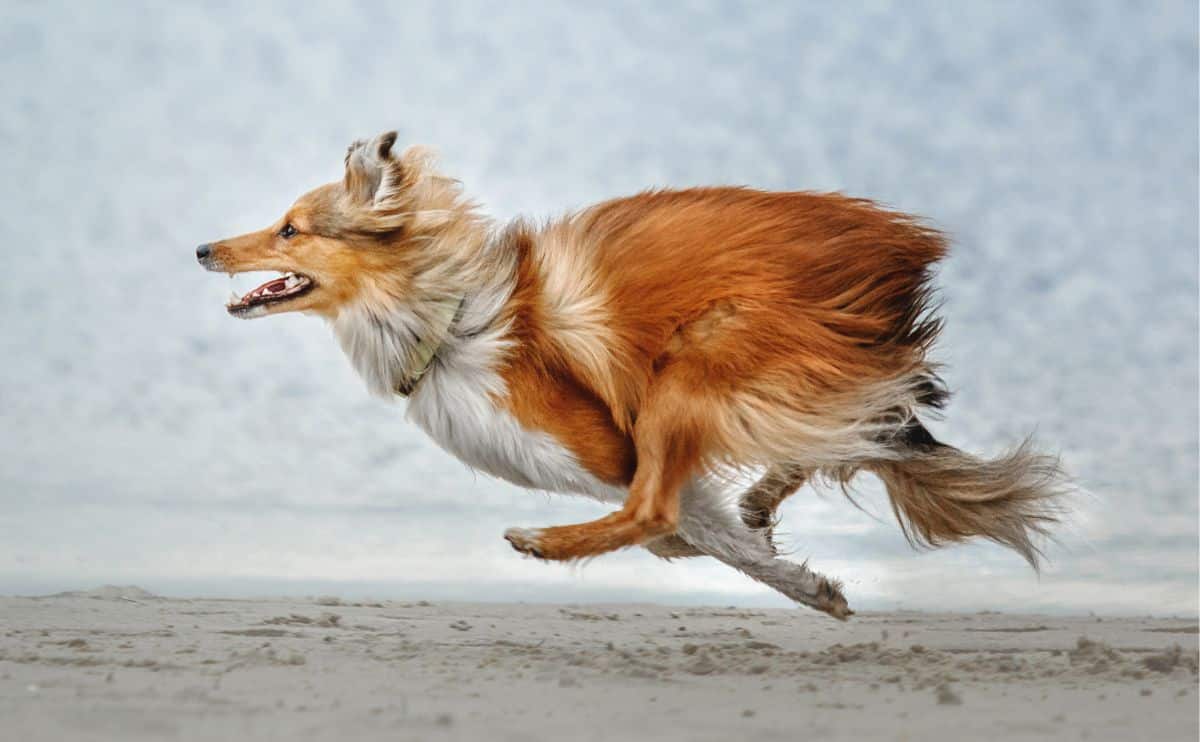How Do Dogs Communicate With Each Other? The Hidden Language You’ve Been Missing
When you purchase through links on our site, we may earn a commission. Here’s how it works.
If you’ve ever watched two dogs meet at the park or on a simple walk — sniffing, circling, then suddenly erupting into play or a scuffle — you’ve probably wondered: What exactly are they saying to each other?
Table of Contents
Do dogs speak to each other? Yes, our canine companions have their own secret language, and it’s way more sophisticated than a few barks and tail wags. In fact, they’re constantly “talking” using body language, vocalizations, and even scent.
Understanding how they “talk” can help you prevent conflict, support better socialization, and deepen the human–canine bond. Ready to learn how to speak dog? Let’s decode it.
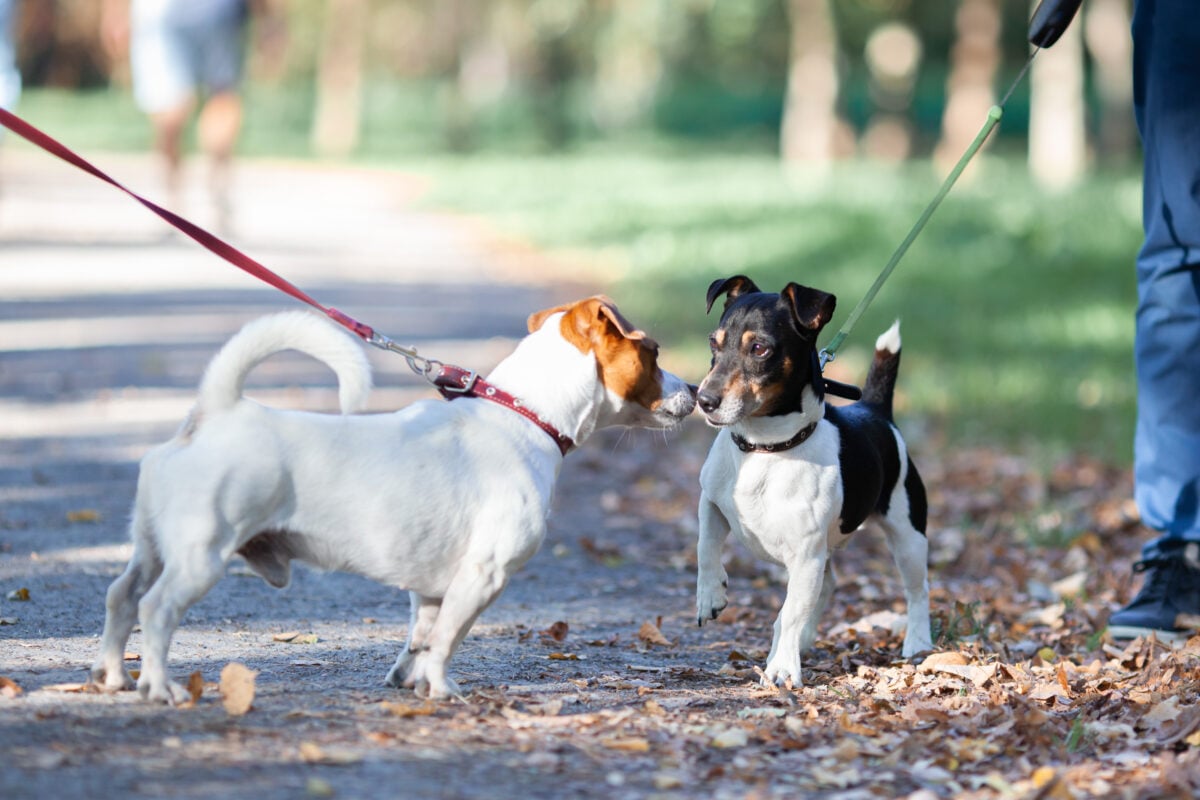
How Do Dogs Communicate With Each Other? A 6-Part Guide To Canine Conversations
Understanding how dogs communicate with each other opens up a whole new world. You’ll start to read situations before they escalate and know when your pup (or their potential new canine friend) is relaxed, nervous, or overstimulated.
By watching how dogs interact and stepping in when needed, you help your pup feel safe, understood, and socially confident.
1. Body Language: The Primary Language Of Dogs
Dogs are highly visual animals, and body posture is the backbone of their communication system. Every shift in weight, tail carriage, or muscle tension conveys valuable information. Once you start noticing it, you’ll see your dog “talking” all the time.
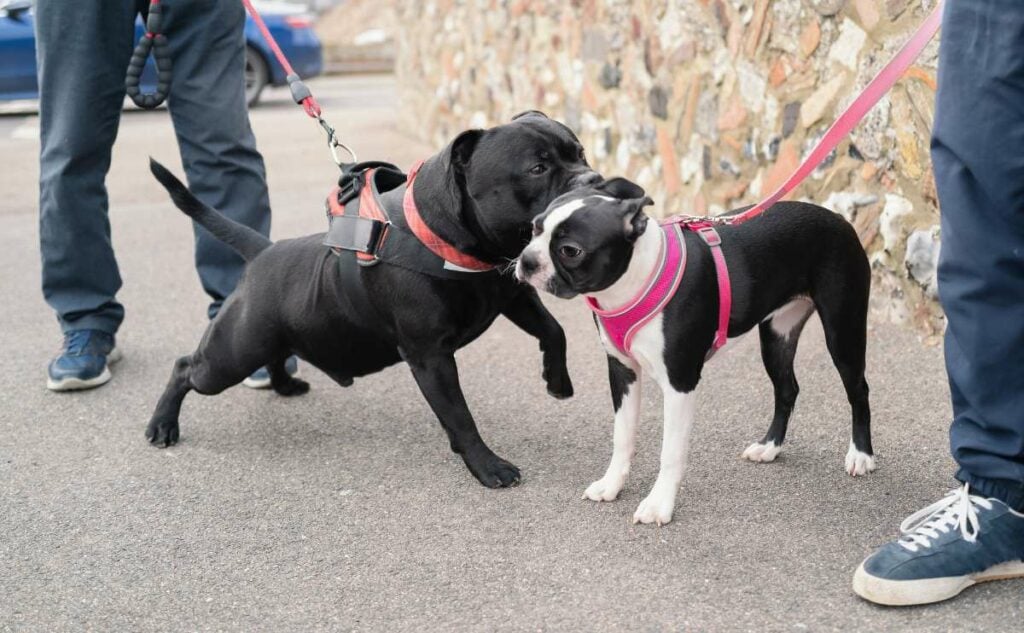
Key Body Signals To Notice
Dogs read each other’s posture like a language. And they adjust their own body accordingly in real time, often faster than humans can detect.
- Tail position
- High and stiff: confident, aroused, or potentially aggressive
- Tucked or low: fearful or submissive
- Loose wag: relaxed and friendly (but wagging doesn’t always mean happy)
- Fast wag and wiggly butt: “I’m thrilled to see you!”
- Posture
- A dog standing tall with forward-shifted weight might be asserting dominance or preparing to react.
- A crouched body with ears back and head lowered signals appeasement or uncertainty.
- The “Play Bow” (front down, butt up)
This is your dog’s way of saying, “Let’s play!” It’s an invitation, not aggression, even if it’s followed by pouncing and zoomies. - Hackles raised
When the hair on a dog’s back stands up, this can signal high excitement, fear, arousal, or anxiety. It’s not always aggression, just emotional overload. - Turning away or yawning
These “calming signals” tell another dog, “I’m not a threat” or “Please calm down.” Dogs often use these to de-escalate tension.
A 2013 study found that dogs can discern emotions by observing left- or right-asymmetric tail wags. Wagging more to the right indicated a more relaxed emotion, while tail wags to the left conveyed uncertainty or wariness. This research suggests that dogs’ brains process emotion similarly to ours.
2. Facial Expressions & Eye Contact: Right Up There With Body Language
Dogs use their faces to signal intent, but these cues are often subtle and easy to miss for owners.
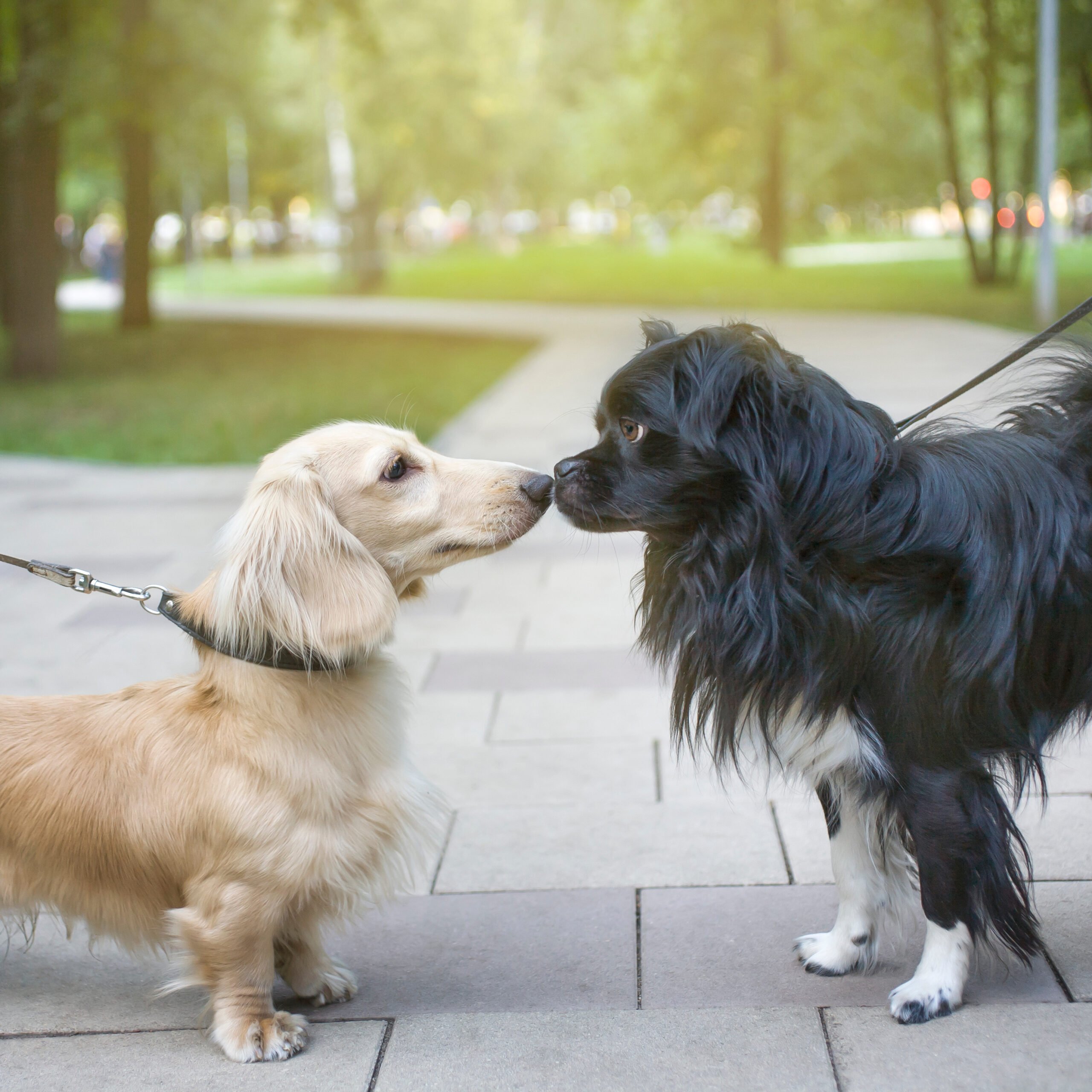
Key Facial Expressions To Notice
- Eye contact
Among dogs, prolonged eye contact is generally confrontational. Brief glances or turning the gaze away are calming signals. - Whale eye (white showing)
A sign your dog feels cornered or anxious. - Mouth position
- A relaxed mouth with loose lips and a soft pant typically means a dog is at ease.
- Tense lips, a closed mouth, or a snarl indicate discomfort or a perceived threat.
- Submissive grin: Some dogs show teeth as a goofy, friendly gesture rather than aggression.
- Ear position
- Relaxed conveys a neutral and unconcerned emotion.
- Flattened and pinned back tightly can mean a dog is concerned, defensive, or uncomfortable.
- Perked or pricked held high and forward, indicating attentiveness, alertness, and interest in something.
Over generations, humans have used selective breeding standards for dogs to create specific physical traits, which has unintentionally reduced the social signaling capacity of several breeds.
For example, brachycephalic (flat-faced) dogs have reduced facial mobility, making it harder for them to display a wide range of facial expressions. Similarly, dogs who have been selectively bred to have erect ears or very short tails have lost some of the communicative functions those features typically provide.
3. Scent & Chemical Signals: The Most Overlooked Forms of Dog Communication
To humans, scent is subtle. To dogs, it’s everything. Dogs live in a world of smells, and scent is how they gather long-term, personal, and often invisible information.

Dogs have a sense of smell that puts ours to shame, thanks to their superhuman olfactory anatomy. First, their noses have up to 300 million olfactory receptors, while ours have a measly 6 million.
But what truly sets their sense of smell apart is the Jacobson’s organ (aka the vomeronasal organ). This special organ sits above the roof of the mouth and does more than just detect smells — it picks up chemical signals (like pheromones) from other dogs, animals, and humans.
The Jacobson’s organ connects directly to the brain and helps dogs with social communication, mating behaviors, and prey detection. It’s a powerful tool humans simply don’t have.
Ways Dogs Use Scent To Communicate
- Urine marking
Dogs leave chemical messages via urine, conveying sex, reproductive status, territory, and emotional state. IDogs leave chemical messages through their urine, conveying information about sex, reproductive status, territory, and emotional state. It’s not just peeing on a bush; it’s targeted social messaging. - Sniffing each other’s rear ends
Weird to us, but it’s a quick way for dogs to identify one another via anal gland secretions. These carry individualized scent profiles, almost like a canine ID card. - Pheromones
Dogs release pheromones that convey emotions such as fear, stress, and happiness, which in turn influence the behavior of other dogs.
4. Vocal Communication: More Than Just Barking
Though silent forms of doggie talk are primary, dogs absolutely use vocalizations to express themselves.
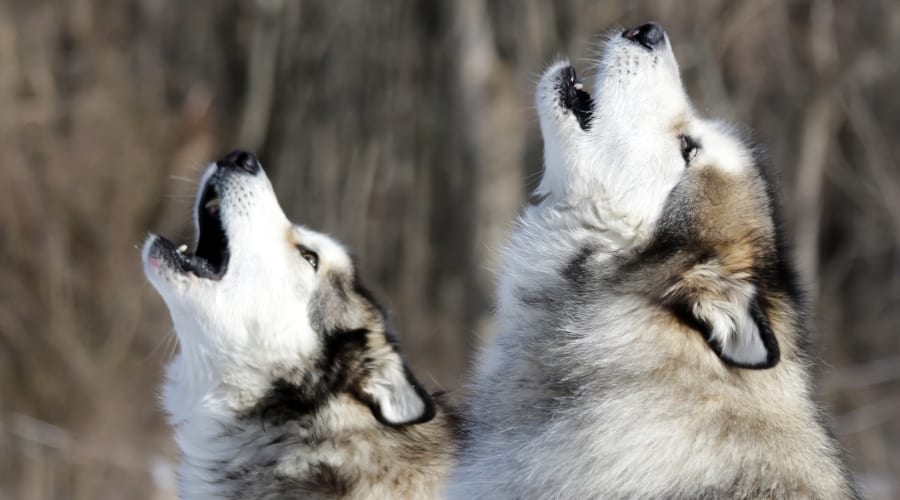
Just like humans interpret tone, dogs modulate their vocalizations based on social context. It’s not just noise; it’s calibrated communication. While not as nuanced as body language, vocal signals play an important supporting role, especially when visibility is limited.
Common Vocal Cues And Their Meanings
- Barks
Dogs bark to alert, protest, invite play, or express frustration. The tone, pitch, and rhythm matter.- Rapid, high-pitched barks often signal excitement.
- Slow, low-pitched barks may indicate a threat.
- Growls
A warning signal, yes, but also used in play. Dogs growl to establish boundaries, and healthy social dogs know when and how to respond appropriately.- Low, rumbling growl: “Give me space.”
- Play growl (often with a wagging tail): Part of roughhousing.
- Whining and yelping
- High-pitched whines usually suggest distress or submission.
- A yelp often follows pain or surprise.
- Howling
A form of long-distance communication, which is more common in certain breeds and often triggered by social isolation or specific frequencies like sirens.
Dogs from different environments or breeds may “speak” in slightly different vocal tones—some are just more talkative than others (we’re looking at you, Huskies).
5. Tactile Communication: When Touch Becomes A Message
Physical contact isn’t random; it often serves a clear communicative function.
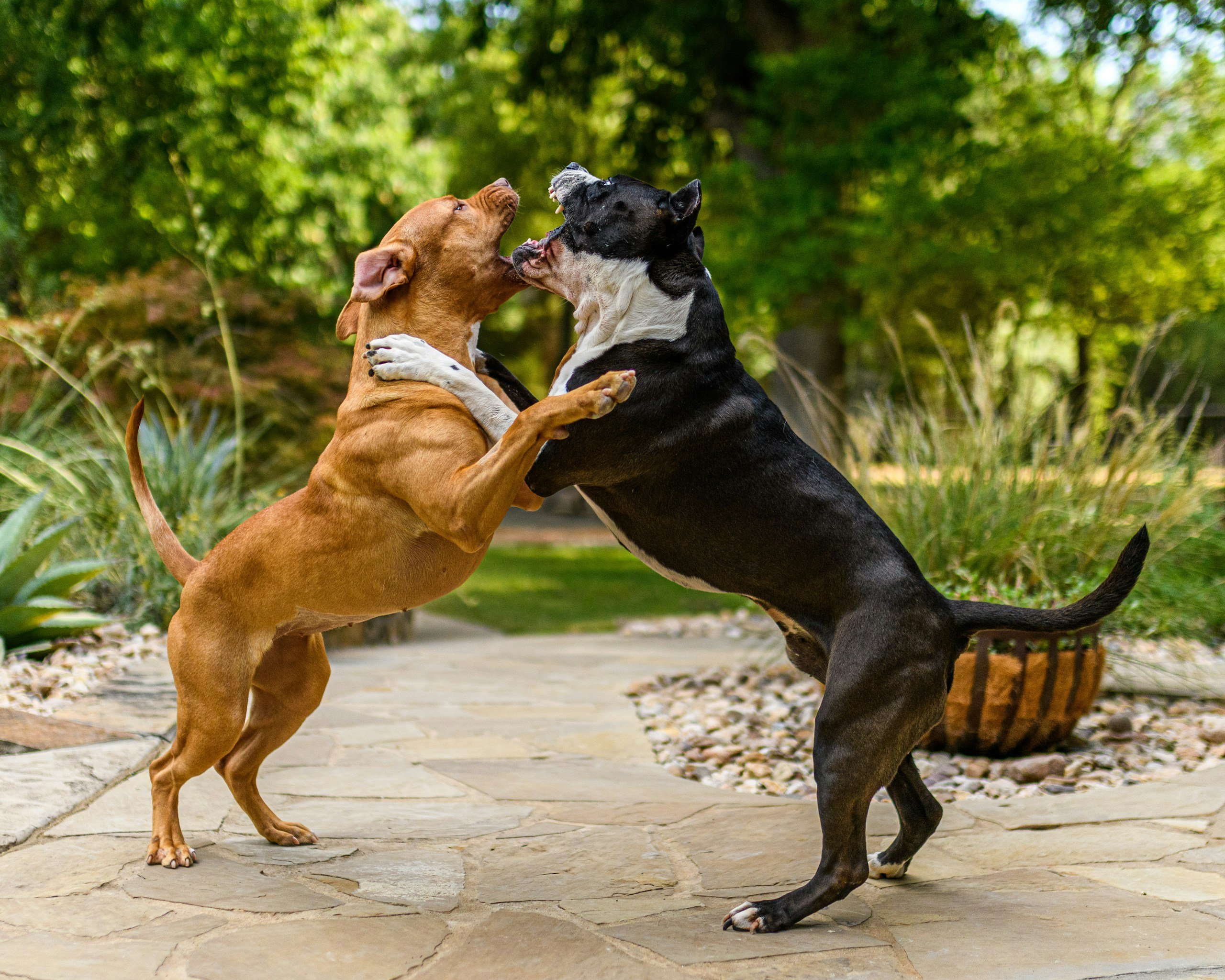
Touch is a form of interactive feedback. Dogs use it to test social limits, affirm relationships, or diffuse tension. The key is reciprocity. Healthy tactile communication flows both ways and is supported by complementary body language.
Common Forms Of Tactile Signaling
- Pawing or placing a paw on another dog
Often an attention-seeking gesture or a mild assertion of status. In puppies, pawing is frequently used to initiate play or interaction. - Muzzle nudging or licking
Dogs may gently nudge another’s muzzle to show deference or initiate social bonding. Submissive dogs often lick the muzzle of more dominant individuals, especially in greetings. - Leaning or body contact
Among bonded dogs, leaning or resting against each other is a form of affiliative behavior similar to social grooming in other species. This kind of touch can reduce stress and strengthen social bonds. - Body slams, shoulder bumps, or mounting in play
In high-arousal play, dogs may use their bodies more assertively. These actions can be part of rough play but may also test boundaries. Context matters: what’s playful for one dog could be unwelcome for another. - Snout pinning or gentle nips
In puppies and adolescents, soft mouthing or nipping is used to explore social feedback. Mature dogs may correct younger ones through restrained tactile corrections, such as pinning, nudging, or holding with the mouth without biting down.
According to studies on canine play behavior, tactile signals are widespread during social play and serve as essential tools for negotiating boundaries and maintaining mutual consent.
6. Social Intelligence: Dogs Adapt Their Communication Based On Context
Perhaps the most remarkable aspect of canine communication is its flexibility. Dogs don’t just send signals; they read the social environment and respond accordingly.
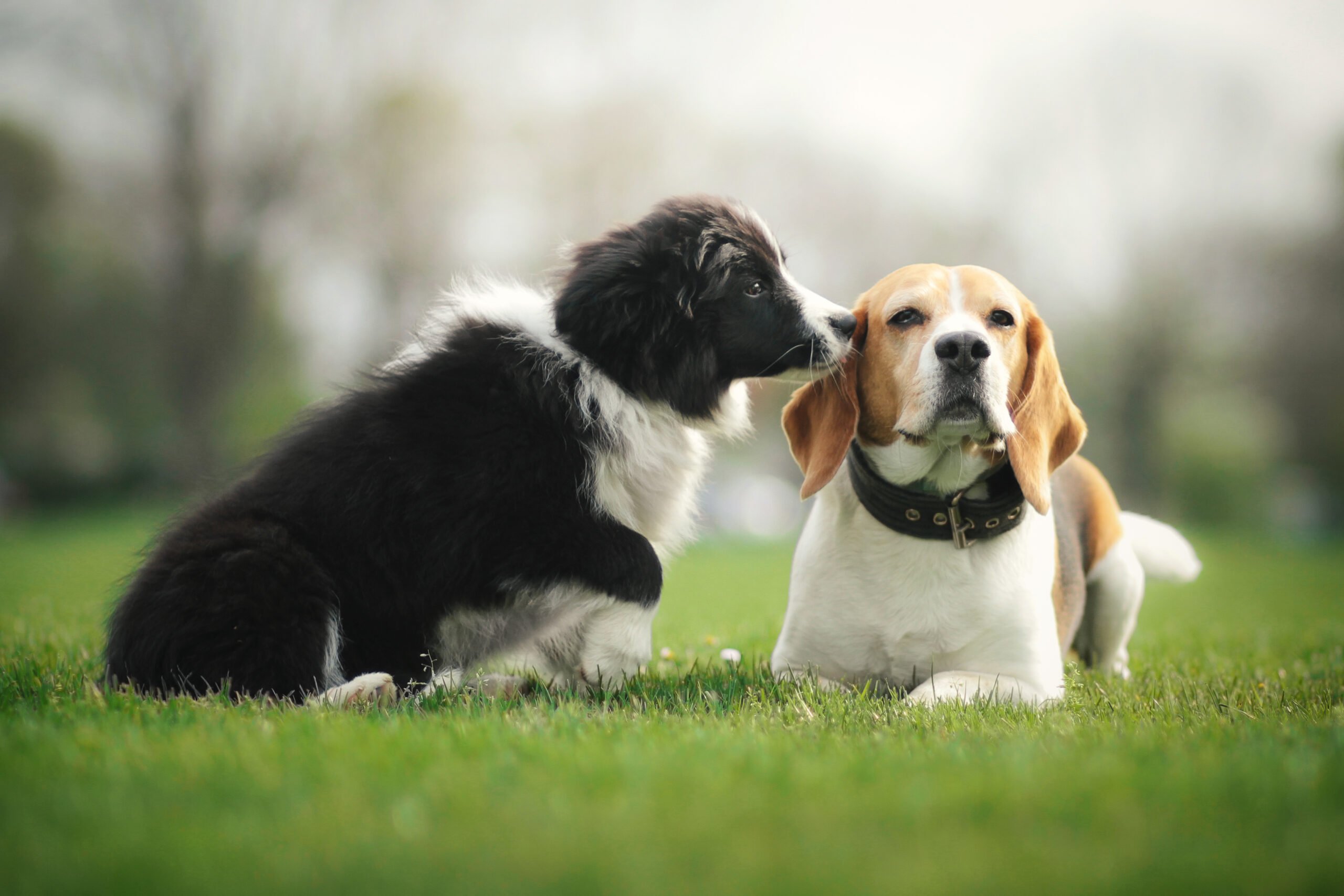
Social Learning In Dog Communication
- Social referencing
Dogs observe the behavior of others, including people and other dogs, to make decisions. If one dog reacts fearfully to a noise, the other may become cautious too. This mirrors what we see in infants. Dogs look to others for cues in uncertain situations. - Deference and escalation
Well-socialized dogs know when to yield and when to assert themselves. Much of dog communication is about preventing conflict through small, subtle exchanges, such as a lip lick, a head turn, or a yawn.
While well-socialized dogs can adjust their behavior depending on the personality of the other dog, a dog who’s been isolated or unsocialized may not “speak dog” fluently, leading to misread signals or conflict.
When Dogs Don’t Understand Each Other
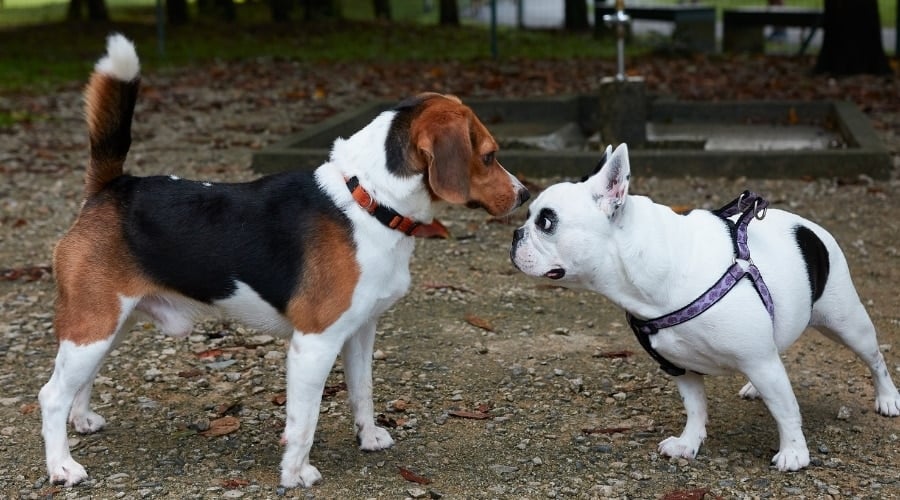
Dog communication isn’t perfect. Misunderstandings happen, especially between:
- Different breeds: A French Bulldog‘s flat face or a Husky’s intense stare can confuse others.
- Different energy levels: A hyper Labrador Retriever might overwhelm a mellow Shih Tzu.
- Poor socialization: Dogs raised alone may not know how to play or read warning signs.
As a pet parent, it’s up to you to supervise interactions and step in before things go south. Look for stiff bodies, fixed stares, and escalating tension.
Why Does Understanding Dog-To-Dog Communication Matter?
Dog communication is sophisticated, intentional, and shaped by evolution. Understanding it helps us:
- Prevent dog fights before they escalate
- Support shy or fearful dogs
- Read when our own dogs are uncomfortable, even when they’re silent
- Foster healthier relationships between dogs in multi-dog households or public spaces
The next time you watch two dogs greet each other, don’t just listen — observe. You’ll start to see the conversation that’s always been there.
Frequently Asked Questions
Pup owners have so many questions about dog-to-dog interactions. You’ll find several often-asked questions (and answers) below. If you don’t see yours here, please let us know in the comments so we can assist you.
Do Dogs Communicate With Each Other?
Yes, our canine companions have highly sophisticated means of communicating with each other. Perhaps more refined and intelligent than humans.
How Do Puppies Learn To Communicate With Other Dogs?
It’s all about play and feedback. Puppies test boundaries and read responses, learning bite inhibition, calming signals, and social rules. Well-socialized puppies exposed to different dogs during critical developmental periods tend to become better communicators as adults.
Do Dogs Really Understand Each Other’s Barks?
Yes, but within context. While barking is less nuanced than body language, dogs respond differently to variations in pitch, repetition, and tone. A fast, high-pitched bark may invite play, while a slower, deeper bark can serve as a warning. Dogs learn to interpret these cues based on experience.
Is Tail Wagging Always A Sign Of Happiness?
No. Tail wagging simply means arousal, not necessarily joy. A loose, sweeping wag usually signals friendliness, but a high, stiff wag, especially combined with a rigid body, can mean the dog is alert, tense, or even agitated.
What’s The Best Way To Tell If Two Dogs Are About To Fight?
Watch for escalating tension: stiff posture, hard staring, freezing, raised hackles, and low growling. If neither dog disengages after early warning signals, the risk increases. Recognizing these signs early is crucial for effective intervention.
Does Your Dog Need Some Training To Play Well With Others?
Socializing puppies at a young age is key, but if you’ve adopted an older dog, it’s not too late to teach them how to interact well with other canines and humans. Here’s our tip from Canine Journal — you don’t have to fork over a ton of money for an in-person dog trainer.
Many of our team members have achieved significant success through online dog training courses, which are significantly more affordable. The best online dog training sites provide excellent, step-by-step tutorials with video, tips, and even personalized feedback from certified dog trainers.
